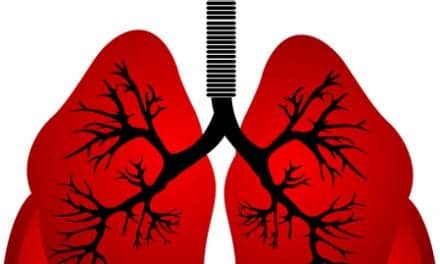A discussion of secretion clearance issues in patients with neuromuscular disorders.
A 20-year-old male with Duchenne muscular dystrophy was having respiratory problems. He had been prescribed an insufflator-exsufflator but was extremely nervous about using one—he had never done so before. Seeing his trepidation, the family became worried and requested antianxiety medication from his physician.
 |
When the dreaded day arrived, the patient went to his physician’s office to learn how to use the device. As it turned out, the patient was not having difficulties because of Duchenne’s alone but because he also had a respiratory syncytial virus (RSV) infection, which had increased the secretions of his pulmonary system. He felt better after the first try and wanted to repeat it immediately. “We spent a fair amount of the day clearing him, and he became an instant fan [of insufflation-exsufflation],” says Howard Panitch, MD, professor of pediatrics and director of the technology dependent center of the pulmonary division at The Children’s Hospital of Philadelphia.
The case illustrates the importance of secretion clearance and the challenges that can impact its use. Often, no one thinks about the issue until the patient has a problem. Yet monitoring a patient’s secretion clearance using measurements, such as the evaluation of cough sufficiency, can help to prevent respiratory problems, improve morbidity, and enhance quality of life. Working with patients to determine what works best for them and teaching them how to manage that process will help to achieve compliance.
“When it comes to the care of patients with neuromuscular weakness, airway clearance is at least as important as thinking about ventilation. You can’t do one without the other and expect someone to do well,” says Panitch.
Where It All Goes Wrong
Patients who are unable to clear secretions are at risk of developing life-threatening conditions, such as pneumonia or atelectasis. “In most cases of neuromuscular disease, respiratory failure and pneumonia are the primary causes of death.”1
“Respiratory health is compromised in a lot of ways by neuromuscular disorders,” says Bruce K. Rubin, MEngr, MD, MBA, FAARC, professor and vice chair for research in pediatrics and professor of physiology and pharmacology at Wake Forest University School of Medicine in Winston-Salem, NC, and professor of biomedical engineering at Virginia Tech in Blacksburg, Va.
Elaborating, he notes that patients with neuromuscular disorders typically have their mobilization impacted and are unable to exercise, preventing good air inflation and reducing the strength needed to clear airways. As their muscles weaken and provide less support to the spine, scoliosis and thoracic deformity are common and can lead to airway restriction. These patients are also more likely to aspirate food and produce an insufficient cough. In the end stages, hypoventilation is often seen, along with an inability to clear secretions.
The ability to produce secretions is rarely impacted in patients with neuromuscular disorders (although Rubin does note that patients with cystic fibrosis [CF] can lack mucus in their airways). “Secretion of mucus at the cellular level is not affected; the problem is expectorating it or clearing it from the airways,” says Panitch.
Cough Components
Science has identified three phases of the cough: inspiratory, compressive, and expiratory. Problems in just one area can impact a patient’s ability to clear secretions. Patients with weak inspiratory muscles may find it difficult to take a deep breath; those with weak expiratory muscles may not be able to contract forcefully enough to expel air and secretions from the airways. Others may not be able to close their glottis. Generally, however, the problem is with coughing as a whole rather than the specific phase. “When you’re weak, you’re typically weak withall,” says Rubin.
Unfortunately, this is often not noticed until a problem has developed. One of the challenges to identifying these patients early is that evaluation of cough is not a routine part of care. No guidelines currently exist covering the routine measurement of cough sufficiency. One big step toward their development, according to Rubin, would be to simply get people thinking about cough and incorporating its monitoring into routine care.
Although it is more commonly done for research purposes, there are some hospital departments that regularly assess cough sufficiency. “I think it’s always a question to be asked if someone is not receiving assistance with their cough. Our practice is to always ask families about the child’s cough to make sure that we don’t have to intervene and help with secretion removal,” Panitch says.
The frequency with which cough sufficiency is reviewed depends on the neuromuscular disorder and its expected course. “Is it progressive or static?” asks Panitch. Patients who frequently suffer pneumonia or atelectasis should be evaluated. “It’s likely the patient does have some difficulty with coughing that needs to be addressed,” says Panitch.
Cough sufficiency can be measured through pulmonary function testing, diaphragm muscle strength, and peak cough flow, which is the most commonly used method. Peak expiratory cough flow has been used as a measure of cough effectiveness since 1966, and Boitano1 writes, “Though the test is nonspecific for evaluating the separate components of cough limitation, it does provide a global measure of cough strength and can be as accurately measured with a peak flow meter as with a pneumotachograph spirometer.”
Here again, guidelines could play an important role, providing standards for measurement and action. Today, a peak expiratory cough flow of less than 160 LPM is used as a threshold for initiating cough-augmentation therapy for neuromuscular patients with cough insufficiency.1 A peak expiratory cough flow less than 270 LPM is considered a risk for complications associated with respiratory infection. “There is a bit of a cushion with a higher peak flow number,” says Panitch.
These numbers are good for adults, but Panitch does not believe there is sufficient evidence to support these same thresholds in children. “We have measured cough peak flows in healthy children, and those under the age of 13 years routinely have flows less than 270 L/min and they don’t get pneumonia. So there is not a standard pediatric number that people have used yet,” he says.
Shaking Things Up
“Once you identify someone’s cough as impaired, I don’t think it’s reasonable to let them be out there without some means to enhance their cough and secretion clearance,” says Panitch. He categorizes therapy in two groups: secretion elimination and mucus mobilization.
Secretion elimination or clearance techniques comprise low-tech and high-tech solutions that assist with all phases of cough. Manual methods include bag valve masks (BVMs), quad coughs, and huffing maneuvers. BVMs enhance the inspiratory phase of a cough using manual ventilation; breath-stacking helps to achieve maximal insufflation. Quad coughs help those with weak expiratory muscle strength. Studies have shown that the manually assisted method produces a significantly higher peak flow cough than unassisted methods in patients with neuromuscular disorders.1 Huffing maneuvers—forced exhalation through an open glottis—improve the compressive phase in patients who are unable to close their glottis.
Mechanical methods can also be used. Insufflation can be administered mechanically using either pressure-limited insufflation or a volume-cycled ventilator with a mouthpiece circuit. Insufflators-exsufflators are also available. Mechanical in-exsufflation is designed to produce a pressure-limited phase that insufflates the lungs, followed by a rapid reversal to negative pressure that removes the insufflated volume at an expiratory flow sufficient to clear secretions, according to Boitano.1
Mucus mobilization includes efforts to “shake secretions up and get them moving mouthward,” says Panitch, citing intrapulmonary percussive ventilation (IPV) and high-frequency chest wall compression (HFCWC) as primary examples.
IPV is a pneumatic device that delivers high-flow-rate bursts of air and aerosol to the lungs at a frequency of 200 to 300 cycles per minute. Regulated, selected topical aerosol can also be precisely delivered throughout the tracheobronchial tree.
“The benefit of IPV is that you can deliver medications with it. A study in adult patients with Duchenne’s found they got more out of IPV than with standard therapy,” says Panitch. A study by Reardon et al2 concluded that the inclusion of IPV within a preventive pulmonary regimen reduced days of antibiotic use and hospitalization for respiratory illness in adolescents with neuromuscular disease.
“The high-frequency chest wall oscillator should do something similar to IPV but has not been studied in patients with neuromuscular disease,” says Panitch. Studies have shown HFCWC to be equivalent to chest percussion and postural drainage in the promotion of airway clearance in patients with CF.3
Rubin writes in a Respiratory Care editorial: “Observational studies of HFCWC suggest that it might reduce the frequency of hospitalization for pneumonia in children with cerebral palsy or family dysautonomia. One small randomized prospective trial in patients with amyotrophic lateral sclerosis found that the addition of HFCWC airway clearance did not provide any clinical benefit for these patients, whereas another short-term study found that HFCWC appeared to reduce the sensation of breathlessness in patients with amyotrophic lateral sclerosis.”3
Rubin counts three types of vests on the market, plus a new sonic device that has no supporting data published yet. Of the first three, Rubin suggests they are expensive but effective in patients with CF. “They are probably effective in people with neuromuscular problems, but not if the patient is so weak that they have an ineffective cough,” says Rubin. Those with severe chest wall deformity or osteoporosis also would not be good candidates.
Particularly for patients with weak cough, combined methods may work best. Boitano1 reports that greater peak cough flow can be produced by combining insufflation therapy with assisted cough, noting: “Bach also reported an improvement in secretion clearance using mechanical in-exsufflation in conjunction with either abdominal thrusts or intermittent abdominal pressure ventilation synchronized with exsufflation,”
Lifestyle choices can also impact conditions. Rubin suggests proper nutrition and avoidance of weight gain, smoking cessation and avoidance of tobacco smoke, and flu shots are simple ways to help maintain cough sufficiency and respiratory health.
Pulmonary Partnership
Whatever treatment path is taken, however, should be decided jointly by the physician and the patient. “When dealing with dynamically changing conditions and different options, you really need to have the patient let you know what is comfortable, what is working, what they can tolerate, and what they like,” says Rubin. Finding a match is more likely to ensure adherence to the program and may be a matter of trial and error.
The RT also plays an important role, providing information to both the patient and the physician. “You need an RT who can talk with the patient and knows how to assess them beyond just listening to the chest. RTs need to understand the devices and approach care as a partner with the patient. RTs can also provide strong advice about clearance to the physician,” says Rubin.
This information could be useful, particularly if there is a lack of protocols. “The people with whom I work in my hospital have become very sensitive to the importance of airway clearance, so we use some of these devices quite frequently. But I hear from people in other places that it is difficult for patients to access some of these devices, so probably they are not being used universally as much as they should be,” says Panitch.
Their use is effective in terms of not only outcomes but also cost. “To have a patient use [a mechanical in-exsufflator] and save even 1 day of hospitalization repays the cost of that machine for the insurance company,” says Panitch. To a patient such as the 20-year-old male with Duchenne’s and an RSV infection, access to these devices is—priceless.
Renee Diiulio is a contributing writer for RT. For further information contact .
References
- Boitano LJ. Management of airway clearance in neuromuscular disease. Respir Care. 2006;51:913-24.
- Reardon CC, Christiansen D, Barnett ED, Cabral HJ. Intrapulmonary percussive ventilation vs incentive spirometry for children with neuromuscular disease. Arch Pediatr Adolesc Med. 2005;159:526-31.
- Rubin BK. High-frequency external chest wall compression for secretion clearance; Shake it, but don’t break it. Respir Care. 2007;52:982-3.









